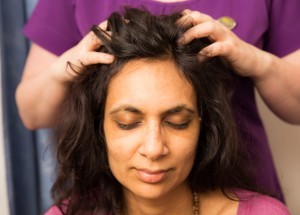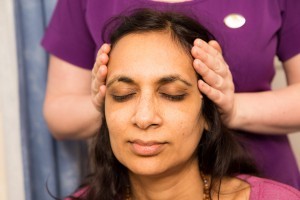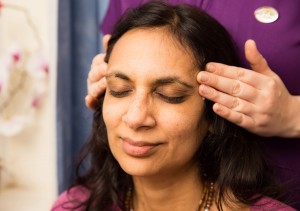Indian Head Massage & Champissage
History
Indian Head Massage first came to the West in 1981 as a small part of the much wider and more holistic practice of Ayurvedic medicine and was first mentioned in Ayurvedic texts a staggering 4,000 years ago. Ayurveda is defined as ‘a way of life, aiming to bring spiritual, mental and physical health’, coming from the Sanskrit words ‘Ayur’ meaning life and ‘veda’ meaning knowledge.
![]() Traditionally head massage in India has a rich and varied heritage. Amongst Indian woman it is often passed down the generations as a way of caring and maintaining social bonds, with oils being applied to the scalp and particularly the hair to keep it strong, healthy, luxuriant and lustrous. Amongst men the ‘champi’ (from which we derive the word ‘shampoo’) or head massage is a regular part of grooming at the barbers and is highly stimulating and fast, in order to invigorate and revive.
Traditionally head massage in India has a rich and varied heritage. Amongst Indian woman it is often passed down the generations as a way of caring and maintaining social bonds, with oils being applied to the scalp and particularly the hair to keep it strong, healthy, luxuriant and lustrous. Amongst men the ‘champi’ (from which we derive the word ‘shampoo’) or head massage is a regular part of grooming at the barbers and is highly stimulating and fast, in order to invigorate and revive.
Treatments
If you have chosen Champissage/Indian Head Massage you have various options. For the full benefits of the massage it is usually best to remove your top or shirt to allow direct contact with the skin, but it can be given through clothing. You can also choose to have the massage with an essential oil blend, plain carrier oils or without oils entirely if you prefer not to have oils in your hair. Indian Head Massage can be performed seated upright, at a massage couch or lying down and if required can be a quick, fast invigorating or long, slow and relaxing treatment as you require.
I practise both this more traditional form, Champissage – a vigorous massage of the shoulders, neck and head which can have revitalizing and stimulating effects, and the more Westernized Indian Head Massage, which is a slower and more calming treatment based upon traditional Champissage. I was trained at the London Centre for Indian Champissage International, who hold the only accredited courses for the original Indian Head Massage and Indian Champissage techniques.
 Benefits of Indian Head Massage
Benefits of Indian Head Massage
There are many potential benefits, not least because it can be performed easily if required – without oils and clothing still on, with no specialized equipment or need to lie down or undress, although many still prefer to use oil blends. Although it focuses upon only the upper body it can also work on the mental and energetic levels as well as physically, so many clients report on a balancing effect for the whole body.
Physical Benefits
Muscular system
- Reduction of stiffness, tension, aches & pains in the scalp, face, neck, shoulders and upper back, and resultant reduction in stress
- Increase in movement in these areas
- Relief for tension & cluster headaches, particularly where tension is held in the neck, back of scalp or in the face
Circulatory system
- Improves blood supply to the whole body as fresh blood is distributed to the cells, carrying Oxygen and nutrients to them and removing waste products such as Carbon Dioxide
- Regular treatment improves circulation to the brain, scalp, face, neck and shoulders
- Increased blood flow may improve the condition of skin and hair, decrease muscular tension and keep the mind and body more alert
- Can lower blood pressure, regulate and strengthen the heart so it may be beneficial for cardiac issues
Lymphatic system
- Can boost the efficiency of the Lymphatic system, thus increasing the removal of waste products, excess fluids and toxins
- This in turn can enhance the immune system, and improve our resistance to disease
 Hair & Scalp
Hair & Scalp
- Increase of circulation to the head and scalp, which can promote hair growth and stimulate the hair follicles and increase sebum production
- Hair can then become more lustrous, rich and shiny with regular treatments
Lungs
- Massage techniques such as percussion/tapotement using cupping, hacking and champi, where the hands are used to tap can be used to tone and stimulate the circulation and help to clear the lungs
Skeletal system & Joints
- Joint stiffness can be eased
- Flexibility and ease & range of movement can be increased
Skin
- Can improve circulation of blood to the skin and encourage desquamation (shedding of dead skin cells) exposing fresh skin cells thus promoting a healthy, glowing complexion
Face
- Reduction of stiffness, tension, aches & pains in the scalp, face, neck, shoulders and upper back, and resultant reduction in stress
- Increase in movement in these areas
- Relief for tension & cluster headaches, particularly where tension is held in the neck, back of scalp or in the face
 Psychological Benefits
Psychological Benefits
Stress & Tension
When too much mental or physical strain is put upon a person the hormonal system changes and the sympathetic nervous system is stimulated. This in turn releases adrenaline and other hormones, causing elevated energy levels, agitation and the ‘fight or flight’ response. This can be crucial in survival situations and highly useful for short periods of time when required, such as a work deadline.
However, during such times the normal equilibrium of the body becomes unbalanced and each individual has their own ‘stress threshold’, that point at which we can no longer cope with the level of stress. This can also lead to poor sleep patterns, exhaustion, increased levels of smoking or drinking, and poor diet, which can create a downward spiral and yet more stress. All sorts of problems and disorders can result: skin conditions such as Ezcema and Psoriasis, digestive problems such as Irritable Bowel Syndrome, depression & irritability, insomnia & poor sleep, cluster headaches and migraine, high or low blood pressure, trouble focusing and concentration.
- During massage clients regularly enter deep states of tranquility and relaxation.
- They can often fall asleep, although upon awakening they often feel more refreshed
- Regular massage can be crucial in allowing you to let go of stress and relax, relearn to ‘rest and digest’ and restablishing the body’s natural balance and boosting the immune system
- Frequently clients report that they have a better quality and quantity of sleep following Indian Head Massage and massage
Subtle & Spiritual Benefits
- Indian Head Massage is designed to work with chakras, the subtle energy centres of the body, balancing and aligning them to help restore balance and equilibrium to the mind, body and spirits
Energy Levels
- Indian Head Massage can release energy held by tension and thus restore or raise energy levels
- Massage of the head and scalp in particular can promote a deep sense of tranquility and relaxation, allowing clients to feel renewed, refreshed and recharged after a massage
